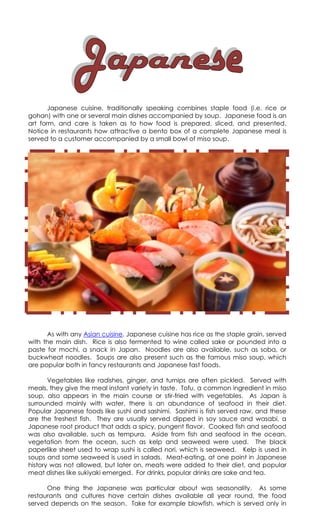
55.7.2.6 japanese
- 1. Japanese cuisine, traditionally speaking combines staple food (i.e. rice or gohan) with one or several main dishes accompanied by soup. Japanese food is an art form, and care is taken as to how food is prepared, sliced, and presented. Notice in restaurants how attractive a bento box of a complete Japanese meal is served to a customer accompanied by a small bowl of miso soup. As with any Asian cuisine, Japanese cuisine has rice as the staple grain, served with the main dish. Rice is also fermented to wine called sake or pounded into a paste for mochi, a snack in Japan. Noodles are also available, such as soba, or buckwheat noodles. Soups are also present such as the famous miso soup, which are popular both in fancy restaurants and Japanese fast foods. Vegetables like radishes, ginger, and turnips are often pickled. Served with meals, they give the meal instant variety in taste. Tofu, a common ingredient in miso soup, also appears in the main course or stir-fried with vegetables. As Japan is surrounded mainly with water, there is an abundance of seafood in their diet. Popular Japanese foods like sushi and sashimi. Sashimi is fish served raw, and these are the freshest fish. They are usually served dipped in soy sauce and wasabi, a Japanese root product that adds a spicy, pungent flavor. Cooked fish and seafood was also available, such as tempura. Aside from fish and seafood in the ocean, vegetation from the ocean, such as kelp and seaweed were used. The black paperlike sheet used to wrap sushi is called nori, which is seaweed. Kelp is used in soups and some seaweed is used in salads. Meat-eating, at one point in Japanese history was not allowed, but later on, meats were added to their diet, and popular meat dishes like sukiyaki emerged. For drinks, popular drinks are sake and tea. One thing the Japanese was particular about was seasonality. As some restaurants and cultures have certain dishes available all year round, the food served depends on the season. Take for example blowfish, which is served only in
- 2. cold months. Salads make do with vegetables available in season and the same goes for main courses. There are also sweets that are available depending on the season and certain foods only available and eaten on specific occasions. Sake, a popular drink in Japan is wine warmed during the fall and winter months. More recipes @ www.gourmetrecipes.com
